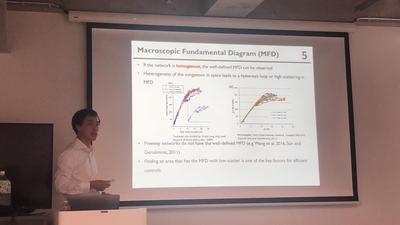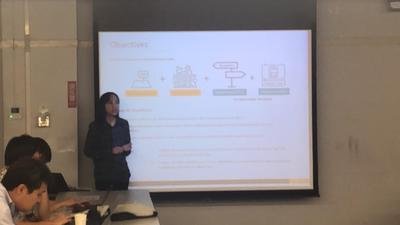Master’s thesis presentation & Summer party
[August 7, 2019]
Today, the Master’s thesis presentation by students admitted in the fall was held, and Ms. Salsabila (M2 student) presented from our laboratory.
She compared the systems and results of TOD (Transit Oriented Development) on residential land prices in the Tokyo metropolitan area using several models. During the question-and-answer session, the professors had a lively discussion about the impact on land prices in neighboring areas and the interpretation of the model’s parameter values.
Mr. Ge, Mr. Dantuji, and Ms. Salsabila, will leave our laboratory next fall, and Prof. Fukuda gave us a few words each about their research life so far. To those who are leaving our laboratory, thank you very much for everything you have done for us in our laboratory!
Master’s thesis submitted by Ms. Salsabila
[2019/07/24]
Today, (M2 student) Ms. Salsabila completed and submitted her master’s thesis.
Ms. Salsabila used several models to compare the accuracy and results of the impact of TOD (Transit Oriented Development) on residential land prices in the Tokyo metropolitan area. Using the MMMM (Multiple Menbership Multilevel Model), a type of regression model that takes into account multiple memberships of rail lines, she found that the value and accessibility of neighboring areas and the distance from the central business district and subcenter significantly affect land prices. The model also shows that land values are higher along railroad lines extending to the southwest of Tokyo.
The 12th and 13th lab seminars
[2019/07/17 & 07/22]
In the 12th and 13th seminar, (M1 students) Mr. Shimizu, Mr. Koyata, Mr. Kita, and Ms. Wang and (D1 student) Mr. Azarel gave their presentations.
Mr. Shimizu and Mr. Koyata presented their research plans and reviewed related research on the analysis of train delays and mobility for the elderly, respectively.
Mr. Kita presented the results of a discrete choice model of the determinants of intention to use a fully automated ride-sharing system, based on the results of an SP survey. He is currently using a Panel Mixed Ordered Logit model for more detailed estimation than before.
Ms. Wang presented a study of traffic accidents caused by tourist excursions and contact between endangered animals and cars, which will be conducted using Bluetooth and Wi-Fi packet sensors, and the concept of using the data for research analysis.
Mr. Azarel presented a literature review on Mobility As A Service (MaaS) and a definition of MaaS for future research.
The 10th and 11th lab seminar!
[July 4 and 12, 2019]
(M2 students) Mr. Ogawa, Mr. Shiroma, Mr. Muro, and Mr. Kawai presented in the 10th and 11th lab seminar.
Mr. Ogawa presented his research on short-term prediction of traffic conditions using recurrent neural networks, from the overview to the analysis results, using data from the central area of Kamakura City.
Mr. Shiroma presented the concept of his research on the analysis of users’ traffic preferences associated with the spread of electric vehicles (EVs).
Mr. Muro presented a review of similar studies and a future research plan on a method to evaluate the effect of transportation infrastructure development using causal inference.
Mr. Kawai presented the concept of a study on office use intention under the assumption that workers can choose the location of their workplaces due to the spread of teleworking, and its application to transportation demand forecasting, as well as the results of basic model estimation.
In the Q&A session, many participants commented on the need to provide a convincing explanation of the purpose and background of the research. I have decided to devote myself to my research even more than before.
Final presentation of doctoral dissertation (Mr. Dantsuji)
[2019/07/03]
The final presentation of the doctoral program was held today, and Mr. Dantsuji (D3 student) presented from our laboratory.
Mr. Dantsuji gave a presentation titled “Modeling and Optimizing Bi-modal Urban Transportation Systems: A Macroscopic Approach”, using 3D-MFD (Macroscopic Fundamental Diagram). Optimization modeling of two modes of transportation, bus and car, was conducted using the 3D-MFD (Macroscopic Fundamental Diagram) as an example for the central Tokyo area.
The professors provided a wide range of active opinions on the model and its purpose.
The 9th and 10th basic seminar
[2019/07/02 & 07/09]
In the 9th basic seminar, (M1) Mr. Kita was in charge of this seminar and taught how to view, edit, and analyze geospatial information, including how to operate QGIS, a free software, and how to create maps and analyze spatial attributes by coding in R. He prepared materials in considerable detail, ranging from ordinary cartography to the creation of colopres maps. This will be useful for research analysis and illustrations for external presentations.
The 10th seminar was led by Ms. Wang (M1), and covered topics ranging from analysis of large-scale data using R to methods for analyzing spatial statistical data.
This is the end of this year’s basic seminar. The materials used in the seminar will be uploaded on the website as soon as they are ready.
(Kawai)
The 5th-8th basic seminars
[2019/06/04,11,18]
In the 5th seminar, Mr. Koyata (M1) gave a lecture on Hierarchical Cluster Analysis and Non-Hierarchical Cluster Analysis (k-means method), from basic theory to coding in R.
In the sixth seminar, Mr. Ukai (B4) conducted the multinomial logit model (MNL), nested logit model (NL), and mixed logit model (MXL), including coding using PandasBiogeme, the third version of Biogeme, which was released in December 2018. PandasBiogeme is the third version of Biogeme, released in December 2018, that can work on Jupyter Notebook and uses the Python package Pandas. As a side note, I personally found it very easy to use compared to the previous version of Biogeme.
In the 7th seminar, Ms. Tabuchi (B4) explained the two shortest path search methods (Dijkstra method and label correction method), from basic theory to coding in R and Python, using simple and virtual networks as examples.
In the 8th seminar, Mr. Shimizu (M1) taught the coding of deterministic user equilibrium (UE) allocation in Python.
(Kawai)
2019 JSCE Conference (Spring Conference)
[2019/06/08]
The 59th JSCE (2019 Spring Conference) was held at Meijo University in Nagoya, Japan. Mr. Shiroma (M2) from our laboratory gave a presentation.
In his presentation, entitled “Time value distribution estimation using multiple data: an empirical analysis of expressway users in the Tokyo metropolitan area,” Mr. Shiroma developed a discrete choice model that explicitly incorporates multiple survey (RP, SP) data and detailed inter-individual heterogeneity to estimate time value distributions that differ depending on the situation in which each individual is placed. The model was applied to the other conditions. During the Q&A session, he received comments from various professors from various universities and companies on the applicability of the model under other conditions and the validity of the time value itself. Thanks all who asked questions. (Kawai)
Master’s course midterm presentation (Ms. Salsa)
[2019/06/05]
The M2 midterm presentations were held today, and Ms. Salsabila presented from our lab.
Ms. Salsa presented the results of her analysis of the impact of Transit Oriented Development (TOD) on land prices in the Tokyo metropolitan area using a MMMM (Multiple Menbership MMMM (Multiple Menbership Multilevel Model), a type of regression model that takes into account multiple memberships of rail lines, was used to analyze the impact of land prices. During the Q&A session, there was a lively discussion on the differences between TOD (Transit Oriented Development), which has long been conducted by Japanese private railway companies, and TOD in other countries, and how to set up the model used. (Kawai)
The 5th to 8th lab seminars in 2019
[2019/05/30, 06/03, 06/06 & 06/13]
In the 5th lab seminar, (new M1 students) Mr. Koyata and Mr. Shimizu presented their graduation research at their home universities and what they would like to do in the future.
Mr. Koyata presented an analysis of the results of a questionnaire survey conducted in the Minato Mirai area regarding people’s acceptance and evaluation of street trees in redevelopment areas.
Mr. Shimizu presented a plan for restructuring the bus transportation network using smart card data, using the Higashi-Hiroshima City network as an example of the measures to be taken and their evaluation.
In the 6th seminar, Mr. Ge gave a lecture on the Markov Decision Model applied to the Q-learning algorithm, followed by presentations by (B4 students) Mr. Ukai and Ms. Tabuchi on their research topics.
In the 7th seminar, Mr. Kita (M1) presented again the contents of his graduation thesis and his future research plan, and Mr. Wang (M1) presented his research plan on flow analysis of tourist attractions using WiFi data.
In the 8th lab seminar, Mr. Azarel (D1) presented his research concept on Mobility as a Service (MaaS). Moreover, Ms. Salsabia (M2) presented the results of several models on the impact of TOD on land prices in the Tokyo metropolitan area and compared them.
(Kawai)











